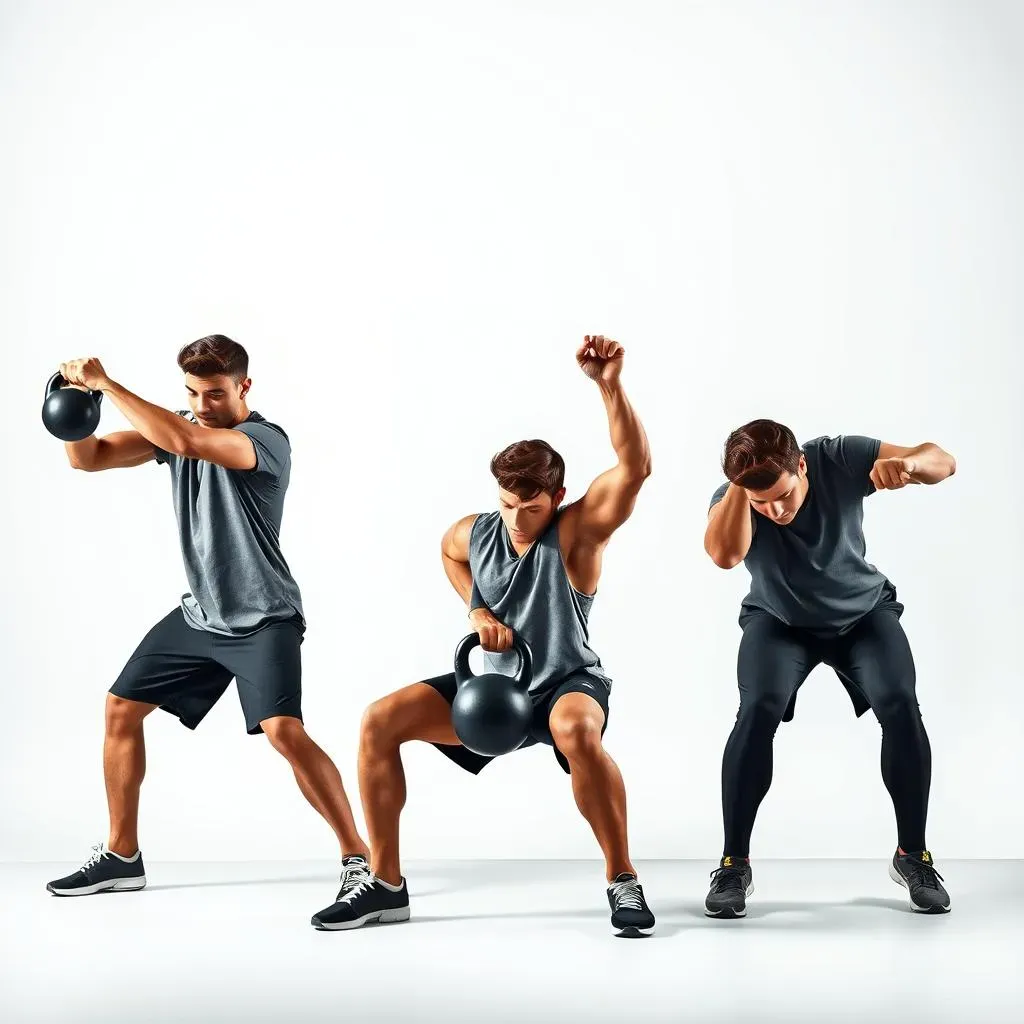Table of Contents
Short on time but big on fitness goals? Then you've come to the right place! This article is your ultimate guide to a killer "15 minute kettlebell workout for beginners". We'll cut through the jargon and get you sweating in no time. Forget complicated routines and confusing exercises – this workout focuses on three fundamental moves that deliver a full-body burn. First, we'll walk you through choosing the right kettlebell and setting up your workout space. Then, it's time to learn the proper form and technique for each exercise: we'll break down the steps to ensure you're doing them safely and effectively. Finally, we'll show you how to build on this 15-minute workout to create a longer, more challenging routine as you get stronger. Get ready to feel the burn, sculpt your muscles, and boost your overall fitness – all in just 15 minutes a day! Let's go!
Getting Started: Choosing Your Kettlebell and Setting Up

Getting Started: Choosing Your Kettlebell and Setting Up
Picking the Perfect Kettlebell
So, you're ready to rock this 15-minute kettlebell workout? Awesome! First things first: the kettlebell itself. Don't worry, you don't need a fancy, expensive one to get started. For beginners, a lighter weight is best – think 8-12 pounds for women and 12-15 pounds for men. You can always increase the weight as you get stronger. Think of it like this: you wouldn't try to run a marathon on your first day, would you? Start small and build up gradually. Many different types are available; if you are unsure which type to choose, check out our ultimate guide to kettlebells.
Remember, proper form is more important than heavy weight, especially when you are starting. Focus on mastering the movements before you increase the weight. If you're unsure, a lighter kettlebell will allow you to focus on technique without risking injury. Trust me, your future self (and your joints) will thank you!
Weight Range | Suggested for |
|---|---|
8-12 lbs | Most Women Beginners |
12-15 lbs | Most Men Beginners |
Setting the Stage for Success
Next, let's talk about your workout space. You don't need a fancy gym membership; your living room will do just fine! Find a spot that's big enough for you to move around freely without bumping into furniture. Make sure you have enough room to swing the kettlebell without hitting anything. A clear space is crucial for safety and preventing accidents. You should also make sure you have enough room to do a full range of motion for each exercise.
Clear the area of any obstacles. This includes pets, kids, and anything that could trip you up. Put on some upbeat music to get you motivated – I find that helps immensely! Also, make sure you have a water bottle handy to stay hydrated. A comfortable workout space can make all the difference.
- Clear space for movement
- Remove tripping hazards
- Upbeat music
- Water bottle nearby
Listen to Your Body
Before starting any new workout routine, it's always a good idea to check with your doctor. This is especially important if you have any pre-existing health conditions. It's better to be safe than sorry! Also, remember to warm up before you start your workout. This could involve some light cardio, like jumping jacks or jogging on the spot, to get your blood flowing. A few dynamic stretches will prepare your muscles for exercise and reduce the risk of injury. Check out this beginner kettlebell program for more information.
Finally, and this is super important: pay attention to your body. If something doesn't feel right, stop! Don't push yourself too hard, especially when you're just starting. Remember, consistency is key to seeing results. It's better to do a shorter, proper workout than a longer, sloppy one that could lead to injury. Remember, we're aiming for progress, not perfection. And progress takes time.
"Listen to your body. It's the best guide you have." - Unknown
The Workout: Three Simple Exercises for a FullBody Blast

The Workout: Three Simple Exercises for a FullBody Blast
Kettlebell Swings: The Foundation
Let's start with the king of kettlebell exercises: the swing! It's deceptively simple, but it works wonders for your entire body. Imagine it like this: you're mimicking the motion of chopping wood – powerful, controlled, and effective. Stand with your feet shoulder-width apart, holding the kettlebell between your legs. Hinge at your hips, keeping your back straight, and swing the kettlebell up to chest height, using your legs and hips for power. Lower it back down under control, and repeat. Aim for 10-12 repetitions.
Focus on using your hips and legs, not your back. A common mistake is to try to use your arms to swing the kettlebell, but that's not the way to do it. Keep your core engaged throughout the movement to maintain stability and prevent injury. For a more detailed guide, check out our basic kettlebell exercises PDF.
Exercise | Reps |
|---|---|
Kettlebell Swings | 10-12 |
Goblet Squats: Legs and Core
Next up are goblet squats. Hold the kettlebell close to your chest, like you're holding a big, heavy goblet. Stand with your feet slightly wider than shoulder-width apart, toes pointing slightly outwards. Lower your body down as if you're sitting in a chair, keeping your back straight and your chest up. Push through your heels to return to the starting position. Aim for 10-12 repetitions.
Remember to keep your weight in your heels and your back straight. Don't let your knees cave inwards. If you're struggling with balance, you can do these squats against a wall for added support. For additional core work, try this beginner kettlebell core workout.
- Feet shoulder-width apart
- Back straight, chest up
- Weight in heels
- 10-12 repetitions
Kettlebell Presses: Upper Body Power
Finally, let's work those shoulders and arms with kettlebell presses. Start by holding the kettlebell at shoulder height, elbows slightly bent. Press the kettlebell straight overhead, fully extending your arms. Slowly lower it back down, keeping control. Aim for 8-10 repetitions per arm. Remember to alternate sides to maintain balance and avoid fatigue.
Keep your core engaged and your back straight. Avoid arching your back or using momentum to lift the kettlebell. Control is key. If you find this exercise too challenging, you can start with lighter weights or do fewer repetitions. If you want a more comprehensive full-body workout, check out our full-body kettlebell workout for beginners.
"The body achieves what the mind believes." - Napoleon Hill
Form and Technique: Mastering the Moves for Best Results

Form and Technique: Mastering the Moves for Best Results
Kettlebell Swings: Perfecting Your Form
Alright, let's talk technique. With kettlebell swings, it's all about the hips. Imagine a powerful hinge movement, like you're trying to pick something heavy off the ground. The kettlebell should be an extension of that movement, not something you're actively "lifting" with your arms. Your back should remain straight, your core engaged, and the power should come from your legs and glutes. Keep those shoulders relaxed and avoid hunching. Think smooth, controlled power, not jerky movements. For more detailed instructions, check out our guide to basic kettlebell exercises.
A common mistake is rounding the back or using the arms to pull the kettlebell up. This can lead to injury, so focus on that hip hinge and keep your core tight. If you're unsure, start with a lighter kettlebell to get the feel of it. Practice in front of a mirror to check your form. Remember, proper form is more important than how many reps you do. A good form will prevent injury.
Focus Point | What to Do | What to Avoid |
|---|---|---|
Hip Hinge | Powerful, controlled movement from the hips | Rounding your back |
Core Engagement | Keep your core tight throughout the movement | Letting your back arch |
Arm Position | Relaxed and not actively lifting the kettlebell | Using your arms to pull the kettlebell up |
Goblet Squats: Depth and Stability
Now, let's nail those goblet squats. The key here is depth and stability. You want to go as low as you comfortably can, keeping your back straight and your chest up. Imagine sitting back into a chair – that's the feeling you should aim for. Your knees should track over your toes, and your weight should be in your heels. Keep your core engaged to maintain balance and protect your lower back. This exercise works wonders for your legs and glutes, while simultaneously engaging your core.
Avoid letting your knees cave inwards or your back round. If you're struggling with balance, you can try performing these squats against a wall for extra support. Remember, proper form is essential to prevent injury and maximize results. If you need more core work, try our beginner kettlebell core workout.
- Maintain a straight back
- Knees track over toes
- Weight in heels
- Controlled descent and ascent
Kettlebell Presses: Controlled Movement
Finally, let's perfect the kettlebell press. This is about controlled power, not brute force. Start with the kettlebell at shoulder height and press it straight overhead with a smooth, controlled movement. Avoid using momentum or jerking the kettlebell up. Lower it back down slowly and with control. Keep your core engaged and your back straight to prevent injury. Focus on that controlled movement and you will see the results.
A common mistake is to use momentum to get the kettlebell overhead. This puts unnecessary stress on your joints. Instead, focus on the strength of your shoulders and arms. Remember, this is a strength training exercise, not a weight-throwing contest! If you are struggling to complete all the reps with proper form, try reducing the weight. For a great full-body routine, try our full-body kettlebell workout.
"The difference between ordinary and extraordinary is that little extra." - Jimmy Johnson
Beyond the 15 Minutes: Building Your Kettlebell Routine

Beyond the 15 Minutes: Building Your Kettlebell Routine
Increasing Intensity and Duration
So, you've conquered the 15-minute workout? Fantastic! Now it's time to level up. One simple way to increase the intensity is by adding more reps or sets to each exercise. Start by adding one or two extra reps per set, and gradually increase as you feel more comfortable. You could also add another round of the entire circuit. Remember, consistency is key, so don't jump to extreme changes too quickly. Listen to your body; it's your best guide. If you're feeling really ambitious, try incorporating some more advanced kettlebell exercises. There are tons of resources online – just make sure you're following proper form to avoid injury. A great resource is our beginner kettlebell program.
Another approach is to increase the weight of your kettlebell. However, only do this once you're confident in your form with the lighter weight. Remember, proper form is always more important than weight. Start by increasing the weight by 2-5 pounds and see how you feel. If you feel comfortable, you can gradually increase it over time. Always prioritize proper form over heavier weights; that's the way to make real progress without injuring yourself.
Method | Description |
|---|---|
Increase Reps/Sets | Add 1-2 reps per set or an extra circuit. |
Increase Weight | Gradually increase weight by 2-5 lbs once form is solid. |
Adding Variety and New Exercises
Once you've mastered the basic exercises, it's time to spice things up! Introduce new exercises to challenge your muscles in different ways. This will not only prevent boredom but also help you build a more well-rounded physique. Consider adding exercises like kettlebell rows, Turkish get-ups, or snatches. These exercises work different muscle groups and will challenge your coordination and strength. Remember, always start with lighter weights and focus on proper form. You can find detailed instructions for these advanced exercises in our basic kettlebell exercises PDF.
You can also incorporate other forms of exercise into your routine, such as cardio or bodyweight training. This will help improve your overall fitness and prevent plateaus. For example, you could add a 5-minute cardio session before or after your kettlebell workout. This could be anything from jumping jacks to running on the spot. Remember to listen to your body and adjust your routine as needed. Don't be afraid to experiment and find what works best for you. Remember, the key is consistency and finding a routine you enjoy.
- Kettlebell Rows
- Turkish Get-Ups
- Snatches
- Cardio (e.g., jumping jacks, running)